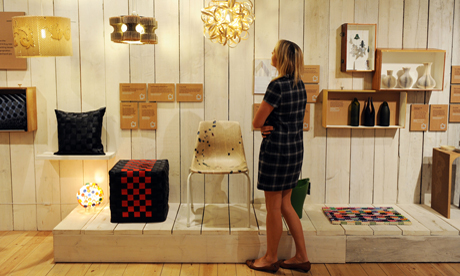Make yourself at eco home

Recycled homeware will be showcased at the Geffrye Museum until early next year
The Eco Home exhibition at the Geffrye Museum, running to 7 February 2010, is a must for anybody with a professional or personal interest in sustainable design and budding eco-enthusiasts alike.
It is curated by eco designer Oliver Heath, who is passionate about the challenge of creating attractive-looking green products; and supported by John Lewis, which has just published The Rise of the Conscious Home, a report about sustainable homes.
The sustainability message is everywhere; we are being forced to rethink our consumption habits and this is reflected in product design. Eco Home encourages us to make small environmentally friendly changes by examining how ecological considerations have come to the forefront of home design.
The exhibition is divided into four sections: saving energy, sustainable materials, lifecycle assessment and recycling. Through presenting a range of established products and more futuristic prototypes, it demonstrates how eco-conscious styles are developing.
One of the most inspired takes on a traditional product is an ingenious integrated toilet and sink, which drains the water from washing your hands straight into the cistern to power the next flush. Another favourite of mine was a prototype of solar-panelled wallpaper, which could harvest and store energy.
One of the rooms displays the REEE chair’s life from ‘cradle to grave’, following its journey from manufacture to repair and finally recycling. Designed and manufactured in the UK, the REEE chair is made recycled plastic from Playstation 2s. Showing this life-cycle gives visitors an idea of the thinking that goes into creating deliberately innovative eco-friendly objects for the home.
Wanting to feel better informed about eco-friendly design issues, I went along to the debate on 12 November about how we can run our homes efficiently and stylishly. What ensued was a lively discussion that explored the issues around making our homes greener.
The debate featured guest speakers Oliver Heath, Sean Allam (Head of Product Servicing at John Lewis), David Kenington (Head of the Energy Saving Trust), Tom Savinger (Strategy and Insight Manager at the Future Laboratory) and Russell Smith (Managing Director at Parity Projects), and was chaired by Alex Godard, who co-curated the exhibition.
Sean Allam spoke about how to change consumer habits. “People are prepared to spend a great deal of money on their homes but they often don’t think about the climate impact before they buy. Just switching to using low-energy lights can make a difference,” he said.
Of course, the audience of this debate weren’t looking to hide behind excuses to avoid reducing their emissions. As one participant pointed out – the panel was preaching to the converted. The challenge is to reach everyone else, especially those on tight budgets – could the exhibition’s message reach them?
David Kenington estimates that the average family can save up to £250 a year just by following some simple and sensible steps for saving energy. The Energy Saving Trust particularly focuses on “delivering cost effective carbon reduction measures, such as loft and cavity wall insulation,” he said.
As technology makes it easier to be more wasteful (think digital photo frames and i-phones), how is it possible to change people’s habits? This question from the audience raised some interesting points.
Tom Savinger explained, “It’s all about considering the pragmatism of the future – we are a technology-driven world and finding a balance that works is important. So instead of trying to adopt a zero carbon lifestyle, go low carbon instead.”
Russell Smith agreed, and talked about the idea of payback – establishing what is important to us and valuable on a moral standing.
He said, “Younger generations will start to change social norms as green thinking becomes a valued part of everyday life.”
Another interesting question raised was the promotion of responsible design through educating students about environmental and sustainable issues. How do we create a generation of design students who are going to bring that incentive to the market?
Oliver Heath agreed that the education doesn’t seem to be there, and that there is a need to reappraise the notion of good contemporary design so that sustainability is embedded within it. Great design is green design that doesn’t compromise on sense of style, he said, it should be worked into its very nature.
The exhibition echoes this sentiment, helping to dispel the myth that good design and style are incongruous with eco-products and conserving the planet.
